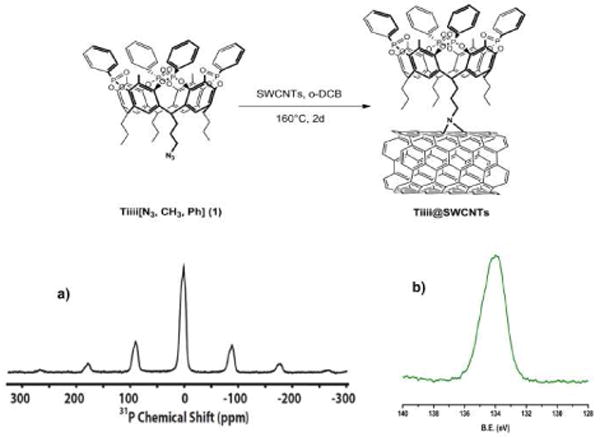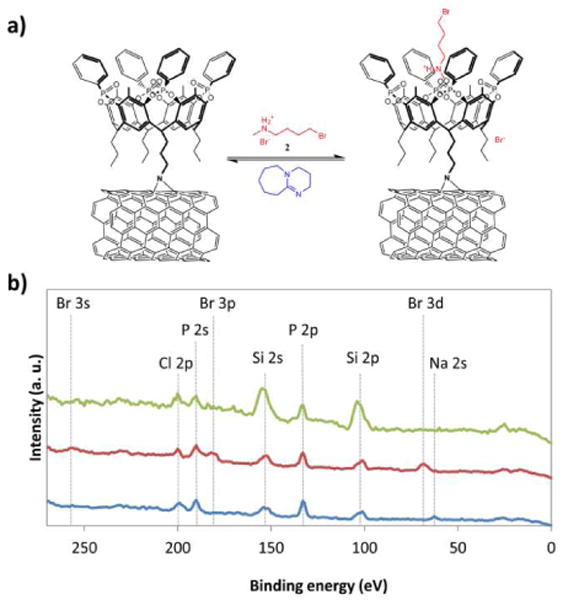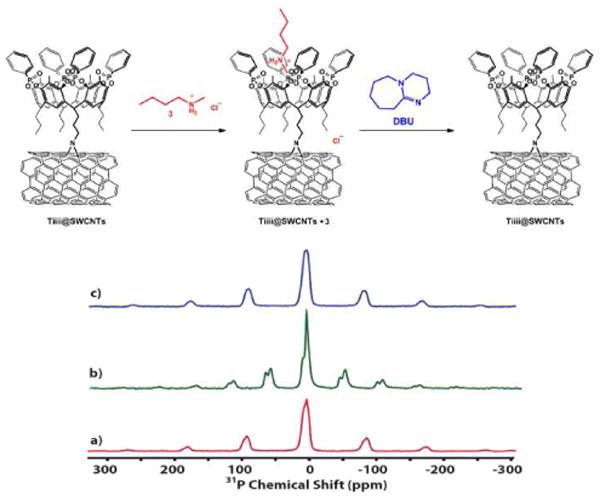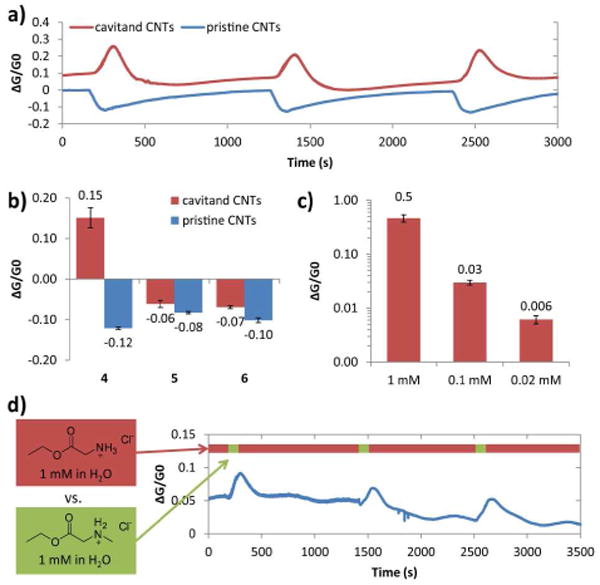Abstract
Single-walled carbon nanotubes (SWCNTs) have been functionalized with highly selective tetraphosphonate cavitand receptors. The binding of charged N-methylammonium species to the functionalized SWCNTs was analyzed by x-ray photoelectron spectroscopy and confirmed by 31P MAS NMR spectroscopy. The cavitand-functionalized SWCNTs were shown to function as chemiresistive sensory materials for the detection of sarcosine and its ethyl ester hydrochloride in water with high selectivity at concentrations as low as 0.02 mM. Exposure to sarcosine and its derivative resulted in an increased conductance, in contrast to a decreased conductance response observed for potential interferents such as the structurally related glycine ethyl ester hydrochloride.
Keywords: Carbon nanotubes, phosphonate cavitands, sarcosine detection, chemoresistive device
Carbon nanotubes (CNTs) are a desirable platform for sensor engineering, because of their electrical properties and quasi one-dimensional structure.1 Although very sensitive to a wide variety of chemical signals, pristine CNTs lack in selectivity.2 Polymers,3 metal nanoparticles4 and biomolecules5 have been used to improve CNTs sensing properties. Embedding molecular recognition units is the ultimate strategy for imparting high selectivity and sensitivity into sensor systems.6 Indeed a host-guest (receptor) approach has proved to be a powerful approach to sensor design and the introduction of cyclodextrins or calixarenes on the sidewall of CNTs has led to the selective recognition of small molecules.7
To further explore the scope of CNT sensing, we have targeted the tetraphosphonate cavitands which offer remarkable complexation capabilities toward charged N-methylammonium species.8 The complex between tetraphosphonate cavitand and N-methylbutyl ammonium chloride exhibits a high Ka value, about 4·105 M-1 in methanol,9 making tetraphosphonate cavitands interesting candidates for specific sensing of methylammonium species. Herein we explore the molecular recognition properties offered by the tetraphosphonate cavitand Tiiii[N3, CH3, Ph]10 1 installed on single-walled CNTs (SWCNTs), toward small ammonium ions in the liquid phase. While non-covalent attachment of the receptors to the CNTs has been shown to provide good sensing results in other systems,7d,e here we have chosen a covalent attachment strategy for better long-term stability of the material under liquid sensing conditions.
The introduction of an azide group at the lower rim of tetraphosphonate cavitands allows the covalent functionalization of SWCNTS by a thermal 1,3-dipolar cycloaddition reaction followed by nitrogen extrusion,11 with very limited structural damage to the CNTs compared to other methods such as oxidation with nitric acid.11a The tetraphosphonate cavitand Tiiii[N3, CH3, Ph], 1, from now onward referred as Tiiii, was prepared in four steps and 45% overall yield, starting from the monohydroxy footed silyl cavitand (see the SI for details).8,12 The key steps of the synthesis were the stereospecific introduction of four inward-pointing phosphonate bridges at the upper rim of the resorcinarene skeleton and the installation of an azide moiety (Scheme S1). The covalent aziridine groups are then installed on the SWCNTs by reaction with Tiiii in o-DCB at 160°C for 2 days.
The covalently functionalized Tiiii@SWCNTs were characterized by attenuated total reflectance fourier transform infrared spectroscopy (ATR FTIR), X-ray photoelectron spectroscopy (XPS), and 31P magic-angle spinning nuclear magnetic resonance (MAS NMR). The infrared spectra (between 1000 and 1500 cm-1) of Tiiii@SWCNTs displayed a broad band arising from the stretching of the PO bonds, P-phenyl group and the aromatic skeleton, which overlap with one another. By comparison with Tiiii ATR FTIR spectra the azide peak are no longer visible for Tiiii@SWCNTs, indicating that aziridination of the SWCNTs has taken place (Figure S2). XPS confirmed the presence of P 2p and N 1s peaks at a density that suggests one cavitand for every 50 CNT carbon atoms, based on the P 2p vs. C 1s signal (Figure 1b and S1).
Figure 1.

SWCNTs functionalization with Tiiii[N3, CH3, Ph] (1); a) 31P MAS NMR spectra of Tiiii@SWCNTs; b) XPS analysis: P 2p region.
MAS NMR was utilized to further analyze the functionalized CNTs. The use of this technique is increasing for the characterization of modified CNTs based on the 13C nucleus.13 However, obtaining high-resolution 13C NMR spectra of CNTs remains a challenge due to the low isotopic abundance (1.1%, 13C) and great variability of carbon sites with different chemical shifts commonly seen in a CNT sample. In contrast to this, a very clear 31P MAS NMR spectrum of Tiiii@SWCNTs was obtained of the SWCNT bound cavitand, which benefited from high 31P natural abundance (100%) and its high gyro-magnetic ratio, both of which lead to greater sensitivity (Figure 1a).
In order to evaluate the molecular recognition capabilities of Tiiii@SWCNTs, we treated a dichloromethane suspension of the functionalized SWCNTs with 4-bromo-N-methylbutylammonium bromide 2, which binds as a guest and has an XPS diagnostic bromide signal.14 After washing to remove any unbound 2, the CNTs were analyzed by XPS. The presence of the Br 3d XPS signals confirmed successful binding of 2 to Tiiii@SWCNTs (Figure 2, red trace; Figure S3). Finally, the sample was washed with 1,8-diazabicyclo[5.4.0]undec-7ene (DBU). In previous experiments, it has been shown that DBU deprotonates the guest thereby breaking the cavitand-guest complex.15 Protonated DBU cannot interact with the cavity as a result of steric hindrance and thereby produces a guest-free host (Figure 2 green trace; Figure S4). Pristine SWCNTs were used as an additional control experiment and no Br signals were detected after similar treatments with 2, thus ruling out non-specific binding to the CNTs (Figure S5).
Figure 2.

XPS binding study with Tiiii@SWCNTs. a) Reversible binding of guest 2; b) XPS analysis of Tiiii@SWCNTs before exposure to 2 (blue), after exposure to 2 (red) and after subsequent washing with DBU (green). Si signals are due to the utilized Si substrate.
To further confirm that the guest binds directly to the cavitand on the CNTs, Tiiii@SWCNTs were treated with a solution of N-methylbutylammonium chloride, 3 and subsequently analyzed by 31P MAS NMR. The 31P signals are sensitive to the structural changes associated with the binding of an ammonium ion to the Tiiii@SWCNTs (Figure 3b, green trace) and a second downfield-shifted resonance is observed. This shift was expected for the host-guest complex and is consistent with solution NMR studies of the base cavitand complex.8b
Figure 3.

Host-guest binding studies using 31P MAS NMR showing reversibility of the host molecule. a) Tiiii@SWCNTs, (red trace); b) after treatment with 3 (green trace) c) after base treatment (blue trace)
To further confirm the binding of ammonium ions to the cavitand, the sample was treated with DBU. MAS NMR of the product after this washing step showed a similar spectrum as was obtained for the pristine Tiiii@SWCNTs confirming the successful removal of the guest (Figure 3c, blue trace). Based upon the reversibility of these associations we can conclude that host-guest association displays the expected pH dependence.
Given the selective ammonium ion binding to functionalized SWCNTs we have created a chemoresistive sensor for the detection of sarcosine, the N-methylated derivative of glycine. Sarcosine is structurally related to the previously studied guests and is a potential biomarker for the progression of prostate cancer.16, 17 In aqueous environments, Tiiii binds sarcosine over glycine with complete selectivity.18 The source of this exquisite selectivity is the presence of water insensitive CH3-π interactions between the N-methyl residue of sarcosine and the hydrophobic internal surface of the Tiiii cavity. Binding between the cavitand and sarcosine is facilitated by the formation of two H-bonds (NH---O=P), hydrophobic interactions, and cation-dipole interactions.
To prepare the sensor, an aliquot of the reaction solution of Tiiii@SWCNTs was directly drop cast onto a glass slide decorated with two Au electrodes. After washing the device to remove any excess of reagent and subsequent drying, the devices where analyzed by scanning electron microscopy (SEM) and atomic force microscopy (AFM) (Figure S6-S7) and the device was put into an enclosure that was connected to a syringe pump (see Figure S9 for a diagram). Using this experimental platform, the device was alternatingly exposed to Milli-Q water and an analyte solution (1 - 0.22 mM) while the current through the CNT network (at Vapp = 50 mV) was measured.
Initial measurements with sarcosine showed an increase in current when a device with Tiiii@SWCNTs was exposed to the analyte at pH 7 (Figure S10). The magnitude of the change in current was however strongly dependent on the pH of the solution and at pH 5, no change in current was observed upon exposure of the device to sarcosine (Figure S11). We attribute this strong pH dependence to the zwitterionic nature of the analyte. Our data may suggest that the protonation of the carboxylate can affect its non-specific interaction with the SWCNT surface. In order to eliminate the effect of the carboxylate, we investigated the hydrochloride salt of sarcosine ethyl ester (4). The measurements were performed at pH 5 to ensure protonation of the amine. As controls, the weaker binding glycine ethyl ester hydrochloride (5) and tetraethylammonium chloride (6) that is too bulky for binding,9 were chosen.
Exposing the device to 4 at pH 5 resulted in an increase in current similar to exposing it to sarcosine, while exposure to 5 or 6 led to a current decrease (Figure 4; Figures S12-S14). In many chemoresistive sensing systems a current change in the same direction is observed for the desired analytes and controls, albeit usually stronger for the target molecule. Instead, a current switch in opposite directions for the target analyte and interferents is rare, especially for compounds as closely related as 4 and 5. Observing a change with a different sign provides a powerful level of selectivity as it can potentially distinguish between analytes regardless of their concentration. Although the magnitude of the response to 4 varied from device to device (Figure S18-S22), an increase in current when exposed to 4 was observed in all cases. Exposing the device to 4 at pH 7 on the other hand, resulted in a current decrease similar to the response to 5 and 6 at pH 5 (Figure S23). Previous studies at the silicon-water interface18 showed that surface complexation by Tiiii is effective only at pH low enough to ensure complete guest protonation. This suggests that specific binding between 4 and the cavitand is reduced as a result of the change in pH and non-specific interactions of 4 and the SWCNTs predominate.
Figure 4.

Liquid flow sensing experiments with Tiiii@SWCNT-based devices at pH 5. a) Tiiii@SWCNT and pristine SWCNTs show opposite responses upon exposure to a 1 mM solution of 4 b) Comparison of the current change upon exposure of Tiiii@SWCNT and pristine SWCNTs devices to 4 (sarcosine ethylester hydrochloride), 5 (glycine ethylester hydrochloride) and 6 (tetraethylammonium chloride), error bars are based on three consecutive measurements c) Response of Tiiii@SWCNT devices to different concentrations of 4, error bars are based on three consecutive measurements d) Response of Tiiii@SWCNT devices to alternating exposure to 4 and 5
Controls with pristine SWCNTs showed a decrease in current for all investigated analytes (Figure 4; Figures S15-S17). In order to minimize the effect of a changing ionic strength of the solution on the sensing response, a device with Tiiii@SWCNTs was alternatingly exposed to a 1 mM solution of 4 and 5 (instead of an analyte solution and water). An increasing current was observed in this case as well when switching to 4 (Figure 4d). Finally, the detection limit for 4 was determined to be 0.02 mM (Figure 4c). It should be noted that the devices exhibited very good stability and no significant change in sensitivity was observed over several months of regular operation.
In summary, we have illustrated the use of covalent functionalized SWCNTs as a selective sensor in water. By introducing a tetraphosphonate cavitand as a specific molecular receptor, it was possible to selectively recognize the N-methylammonium species. The covalent functionalization provided a high stability of a Tiiii@SWCNTs-based device and allowed for the formation of a robust liquid sensing device. As a proof of concept experiment we demonstrated the selective detection of sarcosine ethyl ester hydrochloride, at concentrations as low as 0.02 mM. Interestingly, the sign of the current change upon exposure to the analyte is opposite for the controls, allowing selective detection of the analytes, regardless of their concentration. Studies concerning the sensing mechanism are ongoing in our laboratories.
Supplementary Material
Acknowledgments
This work was supported by Regione Lombardia-INSTM (project SNAF). M. D. thanks the EU through the project BION (ICT-2007-213219) for partial support of his scholarship. J. M. S. thanks the U.S. Army for support through the Institute for Soldier Nanotechnologies (DAAD-19-02-0002). R.G.G. acknowledges the NIH (EB002804 and EB002026) for support. V. K. M. thanks NSERC of Canada for a postdoctoral fellowship. The authors thank Jonathan G. Weis for performing AFM measurements.
Footnotes
Supporting Information Placeholder
Supporting Information. Experimental procedures and analytical data for synthesized Tiiii[N3, CH3, Ph]; XPS and ATR-FTIR characterization of Tiiii@SWCNTs; XPS complexation studies; SEM and AFM images of devices, device setup and operation mode; liquid flow sensing experimental traces. This material is available free of charge via the Internet at http://pubs.acs.org.
References
- 1.(a) Guldi DM, Martìn N, editors. Carbon Nanotubes and Related Structures: Synthesis, Characterization, Functionalization and Applications. Wiley-VCH; Weinheim, Germany: 2010. [Google Scholar]; (b) Schnorr JM, Swager TM. Chem Mater. 2011;23:646–657. [Google Scholar]
- 2.(a) Potyrailo RA, Surman C, Nagraj N, Burns A. Chem Rev. 2011;111:7315–7354. doi: 10.1021/cr2000477. [DOI] [PMC free article] [PubMed] [Google Scholar]; (b) Liu S, Shen Q, Cao Y, Gan L, Wang Z, Steigerwald ML, Guo X. Coord Chem Rev. 2010;254:1101–1116. [Google Scholar]
- 3.(a) Li L, Yang Z, Gao H, Zhang H, Ren J, Sun X, Chen T, Kia HG, Peng H. Adv Mat. 2011;23:3730–3735. doi: 10.1002/adma.201101862. [DOI] [PubMed] [Google Scholar]; (b) Kim TH, Lee BY, Jaworski J, Yokoyama K, Chung WJ, Wang E, Hong S, Majumdar A, Lee SW. ACS Nano. 2011;5:2824–2830. doi: 10.1021/nn103324p. [DOI] [PubMed] [Google Scholar]; (c) Wei B, Zhang L, Chen G. New J Chem. 2010;34:453–457. [Google Scholar]; (d) Wang F, Gu H, Swager TM. J Am Chem Soc. 2008;130:5392–5393. doi: 10.1021/ja710795k. [DOI] [PubMed] [Google Scholar]
- 4.(a) Wei G, Xu F, Li Z, Jandt KD. J Phys Chem C. 2011;115:11453–11460. [Google Scholar]; (b) Fang Y, Guo S, Zhu C, Dong S, Wang E. Chem-Asian J. 2010;5:1838–1845. doi: 10.1002/asia.201000004. [DOI] [PubMed] [Google Scholar]; (c) Lai G, Wu J, Ju X, Yan F. Adv Funct Mat. 2011;21:2938–2943. [Google Scholar]
- 5.(a) Guo X, Gorodetsky AA, Hone J, Barton JK, Nuckolls C. Nature Nanotech. 2008;3:163–167. doi: 10.1038/nnano.2008.4. [DOI] [PMC free article] [PubMed] [Google Scholar]; (b) Sorgenfrei S, Chiu C, Gonzalez RL, jr, Yu YJ, Kim P, Nuckolls C, Shepard K. Nature Nanotech. 2011;6:126–132. doi: 10.1038/nnano.2010.275. [DOI] [PMC free article] [PubMed] [Google Scholar]; (c) Chen JR, Zhang Y, Wang D, Dai H. J Am Chem Soc. 2001;123:3838–3839. doi: 10.1021/ja010172b. [DOI] [PubMed] [Google Scholar]; (d) Lei J, Ju H. Nanomed Nanobiotechnol. 2010;2:496–509. doi: 10.1002/wnan.94. [DOI] [PubMed] [Google Scholar]; (e) Tang X, Bansaruntip S, Nakayama N, Yenilmez E, Chang YI, Wang Q. Nano Lett. 2006;6:1632–1636. doi: 10.1021/nl060613v. [DOI] [PubMed] [Google Scholar]; (f) Wu HC, Chang X, Liu L, Zhao F, Zhao Y. J Mater Chem. 2010;20:1036–1052. [Google Scholar]
- 6.(a) Descalzo AB, Martinez-Manez R, Sancenon F, Hoffmann K, Rurack K. Angew Chem Int Ed. 2006;45:5924–5948. doi: 10.1002/anie.200600734. [DOI] [PubMed] [Google Scholar]; (b) Pirondini L, Dalcanale E. Chem Soc Rev. 2007;36:695–706. doi: 10.1039/b516256b. [DOI] [PubMed] [Google Scholar]
- 7.(a) Ogoshi T, Ikeya M, Yamagishi T, Nakamoto Y, Harada A. J Phys Chem C. 2008;112:13079–13083. [Google Scholar]; (b) Zhao YL, Stoddard JF. Acc Chem Res. 2009;42:1161–1171. doi: 10.1021/ar900056z. [DOI] [PubMed] [Google Scholar]; (c) Wang F, Yang Y, Swager TM. Angew Chem Int Ed. 2008;47:8394–8396. doi: 10.1002/anie.200802762. [DOI] [PubMed] [Google Scholar]; (d) Wang F, Swager TM. J Am Chem Soc. 2011;133:11181–11193. doi: 10.1021/ja201860g. [DOI] [PubMed] [Google Scholar]; (e) Kong L, Wang J, Meng F, Chen X, Jin Z, Li M, Liu J, Huang XJ. J Mater Chem. 2011;21:11109–11115. [Google Scholar]
- 8.(a) Yebeutchou RM, Tancini F, Demitri N, Geremia S, Mendichi R, Dalcanale E. Angew Chem, Int Ed. 2008;47:4504–4508. doi: 10.1002/anie.200801002. [DOI] [PubMed] [Google Scholar]; (b) Yebeutchou RM, Dalcanale E. J Am Chem Soc. 2009;131:2452–2453. doi: 10.1021/ja809614y. [DOI] [PubMed] [Google Scholar]
- 9.Dionisio M, Oliviero G, Menozzi D, Federici S, Yebeutchou RM, Schmidtchen FP, Dalcanale E, Bergese P. J Am Chem Soc. 2012;134:2392–2398. doi: 10.1021/ja210567k. [DOI] [PubMed] [Google Scholar]
- 10.For the nomenclature adopted for phosphonate cavitands see: Pinalli R, Suman M, Dalcanale E. Eur J Org Chem. 2004:451–462.
- 11.(a) Gao C, He H, Zhou L, Zheng X, Zhang Y. Chem Mat. 2009;21:360–370. [Google Scholar]; (b) Tasis D, Tagmatarkis N, Bianco A, Prato M. Chem Rev. 2006;106:1105–1136. doi: 10.1021/cr050569o. [DOI] [PubMed] [Google Scholar]
- 12.Hauke F, Myles AJ, Rebek J., Jr Chem Commun. 2005:4164–4166. doi: 10.1039/b506048f. [DOI] [PubMed] [Google Scholar]
- 13.(a) Singh P, Kumar J, Toma FM, Raya J, Prato M, Fabre B, Verma S, Bianco A. J Am Chem Soc. 2009;131:13555–13562. doi: 10.1021/ja905041b. [DOI] [PubMed] [Google Scholar]; (b) Singh P, Toma FM, Kumar J, Venkatesh V, Raya J, Prato M, Verma S, Bianco A. Chem Eur J. 2011;17:6772–6780. doi: 10.1002/chem.201100312. [DOI] [PubMed] [Google Scholar]; (c) Engtrakul C, Davis MF, Mistry K, Larsen BA, Dillon AC, Heben MJ, Blackburn JL. J Am Chem Soc. 2010;132:9956–9957. doi: 10.1021/ja101955e. [DOI] [PubMed] [Google Scholar]
- 14.Biavardi E, Favazza M, Motta A, Fragalà IL, Massera C, Prodi L, Montalti M, Melegari M, Condorelli GG, Dalcanale E. J Am Chem Soc. 2009;131:7447–7455. doi: 10.1021/ja901678b. [DOI] [PubMed] [Google Scholar]
- 15.Biavardi E, Battistini G, Montalti M, Yebeutchou RM, Prodi L, Dalcanale E. Chem Commun. 2008:1638–1640. doi: 10.1039/b801729h. [DOI] [PubMed] [Google Scholar]
- 16.Sreekumar A, Poisson LM, Rajendiran TM, Khan AP, Cao Q, Yu J, Laxman B, Mehra, Lonigro RJ, Li Y, Nyati MK, Ahsan A, Kalyana-Sundaram S, Hau B, Cao X, Byun J, Omenn GS, Ghosh D, Pennethur S, Alexander DC, Berger A, Shuster JR, Wei JT, Varambally S, Beecher C, Chinnaiyan AM. Nature. 2009;457:910–915. doi: 10.1038/nature07762. [DOI] [PMC free article] [PubMed] [Google Scholar] [Research Misconduct Found]
- 17.Jentzmik F, Stephan C, Miller K, Schrader M, Ebersdobler A, Kristiansen G, Lein M, Jung K. Eur Urol. 2010;58:12–18. doi: 10.1016/j.eururo.2010.01.035. [DOI] [PubMed] [Google Scholar]
- 18.Biavardi E, Tudisco C, Maffei F, Motta A, Massera C, Condorelli GG, Dalcanale E. Proc Natl Acad Sci USA. 2012;109:2263–2268. doi: 10.1073/pnas.1112264109. [DOI] [PMC free article] [PubMed] [Google Scholar]
Associated Data
This section collects any data citations, data availability statements, or supplementary materials included in this article.


